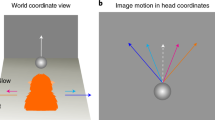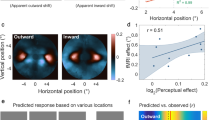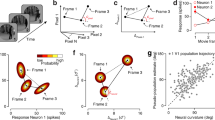Abstract
Spatial information is conveyed to the primary visual cortex in retinal coordinates. Movement trajectory programming, however, requires a transformation from this sensory frame of reference into a frame appropriate for the selected part of the body, such as the eye, head or arms1,2,3,4. To achieve this transformation, visual information must be combined with information from other sources: for instance, the location of an object of interest can be defined with respect to the observer's head if the position of the eyes in the orbit is known and is added to the object's retinal coordinates. Here we show that in a subdivision of the monkey parietal lobe, the ventral intraparietal area (VIP), the activity of visual neurons is modulated by eye-position signals, as in many other areas of the cortical visual system5,6,7,8,9,10. We find that individual receptive fields of a population of VIP neurons are organized along a continuum, from eye to head coordinates. In the latter case, neurons encode the azimuth and/or elevation of a visual stimulus, independently of the direction in which the eyes are looking, thus representing spatial locations explicitly in at least a head-centred frame of reference.
This is a preview of subscription content, access via your institution
Access options
Subscribe to this journal
Receive 51 print issues and online access
$199.00 per year
only $3.90 per issue
Buy this article
- Purchase on Springer Link
- Instant access to full article PDF
Prices may be subject to local taxes which are calculated during checkout





Similar content being viewed by others
References
Bernstein, N. The Coordination and Regulation of Movements(Pergamon, Oxford, (1967)).
Georgopoulos, A. P., Schwartz, A. B. & Kettner, R. E. Neuronal population coding of movement direction. Science 233, 1416–1419 (1986).
Soechting, J. F. & Flanders, M. Sensorimotor representations for pointing to targets in three-dimensional space. J. Neurophysiol. 62, 582–594 (1989).
Masino, T. & Knudsen, E. I. Horizontal and vertical components of head movement are controlled by distinct neural circuits in the barn own. Science 345, 434–437 (1990).
Andersen, R. A., Bracewell, R. M., Barash, S., Gnadt, J. W. & Fogassi, L. Eye position effects on visual, memory, and saccade-related activity in areas LIP and 7a of macaque. J. Neurosci. 10, 1176–1196 (1990).
Andersen, R. A. & Mountcastle, V. B. The influence of angle of gaze upon the excitability of light-sensitive neurons of posterior parietal cortex. J. Neurosci. 3, 532–548 (1983).
Bremmer, F., Ilg, U. J., Thiele, A., Distler, C. & Hoffmann, K.-P. Eye position effects in monkey cortex. I: Visual and pursuit related activity in extrastriate areas MT and MST. J. Neurophysiol. 77, 944–956 (1997).
Galletti, C., Battaglini, P. P. & Fattori, P. Eye position influence on the parieto-occipital area PO(V6) of the macaque monkey. Eur. J. Neurosci. 7, 2486–2501 (1995).
Boussaoud, D., Barth, T. M. & Wise, S. P. Effect of gaze on apparent visual responses of monkey frontal cortex neurons. Exp. Br. Res. 91, 202–212 (1993).
Galletti, C. & Battaglini, P. P. Gaze-dependent visual neurons in area V3A of monkey prestriate cortex. J. Neurosci. 9, 1112–1125 (1989).
Hyvrinen, J. Regional distribution of functions in parietal association area 7 of the monkey. Brain Res. 206, 287–303 (1981).
Andersen, R. A., Asanuma, C., Essick, G. & Siegel, R. M. Corticocortical connections of anatomically and physiologically defined subdivisions within the inferior parietal lobule. J. Comp. Neurol. 296, 65–113 (1990).
Colby, C. L. & Duhamel, J.-R. Heterogeneity of extrastriate visual areas and multiple parietal areas in the macaque monkey. Neuropsychologia 29, 487–515 (1991).
Colby, C. L. & Duhamel, J.-R. Spatial representations for action in parietal cortex. Cog. Brain Res. 5, 105–115 (1996).
Maunsell, J. H. R. & Van Essen, D. C. The connections of the middle temporal visual area (MT) and their relationship to a cortical hierarchy in the macaque monkey. J. Neurosci. 3, 2563–2586 (1983).
Ungerleider, L. G. & Desimone, R. Cortical connection of area MT in the macaque. J. Comp. Neurol. 248, 190–222 (1986).
Colby, C. L., Duhamel, J. R. & Goldberg, M. E. Ventral Intraparietal area of the macaque monkey: anatomic location and visual response properties. J. Neurophysiol. 69, 902–914 (1993).
Duhamel, J.-R., Colby, C. L. & Goldberg, M. E. in Brain and Space(ed. Paillard, J.) 223–236 (Oxford Univ. Press, Oxford, (1991)).
Bremmer, F., Duhamel, J.-R., Ben Hamed, S. & Graf, W. in Contribution of the Parietal Lobe to Orientation in Three-Dimensional Space(eds Thier, P. & Karnath, O.) 619–631 (Springer, Berlin and Heidelberg, (1997)).
Duhamel, J.-R., Colby, C. L. & Goldberg, M. E. Ventral intraparietal area of the macaque: congruent visual and somatic response properties. J. Neurophysiol.(in the press).
Matelli, M., Luppino, G., Murata, A. & Sakata, H. Independent anatomical circuits for reaching and grasping linking the inferior parietal sulcus and inferior area 6 in macaque monkey. Soc. Neurosci. Abstr. 20, 404.4 (1994).
Lewis, J. W. & Van Essen, D. C. Connections of visual area VIP with somatosensory and motor areas of the macaque monkey. Soc. Neurosci. Abstr. 22, 160.4 (1996).
Duhamel, J.-R., Colby, C. L. & Goldberg, M. E. The updating of the representation of visual space in parietal cortex by intended eye movements. Science 255, 90–92 (1992).
Gnadt, J. W. & Andersen, R. A. Memory related motor planning activity in posterior parietal cortex of macaque. Exp. Br. Res. 70, 216–220 (1988).
Galletti, C., Battaglini, P. P. & Fattori, P. Parietal neurons encoding spatial locations in craniotopic coordinates. Exp. Brain Res. 96, 221–229 (1993).
Graziano, M. S. A., Yap, G. S. & Gross, C. G. Coding of visual space by premotor neurons. Science 266, 1054–1056 (1994).
Zipser, D. & Andersen, R. A. Aback-propagation programmed network that simulates response properties of a subset of posterior parietal neurons. Nature 331, 679–684 (1988).
Fogassi, L. et al. Coding of peripersonal space in inferior premotor cortex (area F4). J. Neurophysiol. 76, 141–157 (1996).
Tann, J., Boussaoud, D., Boyer-Zeller, N., Moret, V. & Rouiller, E. M. Parietal inputs to dorsal vs. ventral premotor areas in the macaque monkey: a multiple anatomical tracing study. Soc. Neurosci. Abstr., 22, 430.6 (1996).
Acknowledgements
This research was supported by a HCM network grant from the European Community and by the Human Frontier Science Program.
Author information
Authors and Affiliations
Corresponding author
Rights and permissions
About this article
Cite this article
Duhamel, JR., Bremmer, F., Ben Hamed, S. et al. Spatial invariance of visual receptive fields in parietal cortex neurons. Nature 389, 845–848 (1997). https://doi.org/10.1038/39865
Received:
Accepted:
Issue Date:
DOI: https://doi.org/10.1038/39865
This article is cited by
-
Distributions of Visual Receptive Fields from Retinotopic to Craniotopic Coordinates in the Lateral Intraparietal Area and Frontal Eye Fields of the Macaque
Neuroscience Bulletin (2024)
-
Integration of landmark and saccade target signals in macaque frontal cortex visual responses
Communications Biology (2023)
-
Multisensory-driven facilitation within the peripersonal space is modulated by the expectations about stimulus location on the body
Scientific Reports (2022)
-
From embodying tool to embodying alien limb: sensory-motor modulation of personal and extrapersonal space
Cognitive Processing (2021)
-
Parietal maps of visual signals for bodily action planning
Brain Structure and Function (2021)
Comments
By submitting a comment you agree to abide by our Terms and Community Guidelines. If you find something abusive or that does not comply with our terms or guidelines please flag it as inappropriate.



